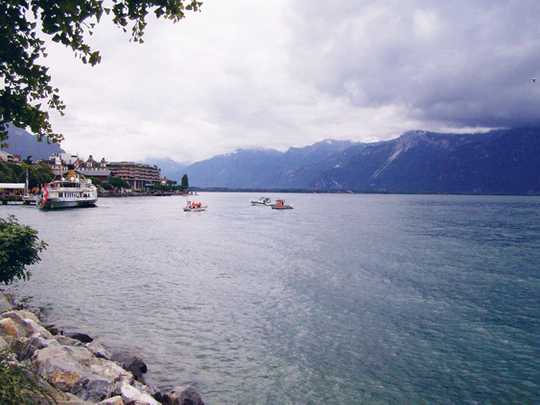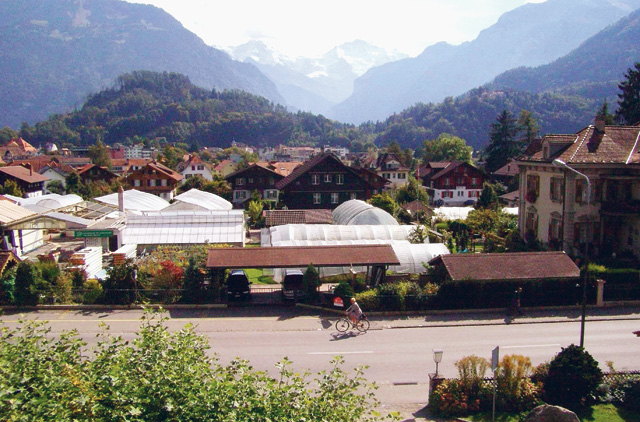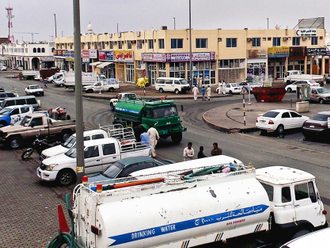
"Your passports, please," the uniformed inspector asked us in German. It looked like a scene straight out of a Hollywood Second World War classic. We almost half expected to be hauled from our train at the Austrian border town of Buchs to some remote prison camp.
Fortunately, we weren't Clint Eastwood or Richard Burton on some Where Eagles Dare mission into enemy territory. And neither was this 1945. This was the autumn of 2010 and we were just a bunch of wide-eyed tourists on our magical ten-day Swiss-Austria tour. Formalities over, we were waved with a friendly nod into Austria and on to the second leg of our trip that had begun a week ago, in the fairytale mountains of Switzerland.
SWITZERLAND
Arriving at Zurich Airport six days ago, we transferred directly by train to Interlaken, after activating our eight-day Swiss Pass that offers unlimited travel time on the rail, bus and ferry network.
Interlaken is one of the most famed destinations in Switzerland and a starting point for major mountain excursions. That evening we took a leisurely walk along the Hoheweg — an inviting 700-metre long boulevard with hotels, cosy cafés, fashion boutiques and watch stores. It felt lovely to tuck into some cheese fondue and sip on local beverages in the evening chill.
The next morning we headed for our first one up the Jungfraujoch — at 3,454 metres, the highest railway station in Europe. This memorable trip took us via Lauterbrunnen and Wengen to the foot of the famous Eiger North Wall, after which the Jungfraujoch railway took us up to a world of eternal ice and snow.
As our train trudged up the snow-covered tracks past fir trees weighed down by snow, I was reminded of the many Christmas cards I used to receive as a child.
The snowfall, unfortunately, also meant that we would not be able get breathtaking views of the Aletsch Glacier, the longest glacier in the Alps, or the other awesome sights from the top of Jungfraujoch.
Yet the journey was worth its weight in gold … err, snow.
I experienced snowfall for the first time and I couldn't help frolicking in the snow to my heart's content. We especially liked the Ice Palace with its sculptures made of ice.
On the return leg late in the evening, we saw many people get off at Lauterbrunnen, which is known for its scenery and the world famous Trumbelbach Falls, but we had a tight schedule, so no stopping for us.
Switzerland is best experienced by train, which takes you through some of the most incredible countryside and mountain trails. As you chug past snow-capped Alps, gurgling streams, sleepy chalets and waterfalls rushing down steep, lush green mountains, you can't help but go "wow".
The next day we moved our base to Lucerne, from where we planned on visiting Mount Titlis, Mount Pilatus and Mount Rigi, which offer awesome views of the regions around Lucerne. However, to our bad luck, we were informed by the railway clerk that Mount Titlis would be impossible due to heavy snow so, "Why don't you try your luck with Mount Rigi tomorrow?"
Disappointing though it was, we did not let it get us down and after a brief break at our hotel, we walked down to the lake, from where we embarked on a three-hour round-trip cruise by ferry to Vitznau (free with Swiss Pass), on Lake Lucerne.
Walk around
The ferry point is just off the futuristic Culture and Convention Centre, designed by leading French architect Jean Nouve, next to the train and bus station.
Lucerne is a city of town squares and churches and walking around is an ideal way to discover it. The wooden, covered Chapel Bridge, complete with medieval paintings, is the centrepiece of the townscape. We also caught up on some of Lucerne's famed sights, such as the Lion Monument and the Museggmauer.
The next morning we were headed to Mount Rigi. Taking the ferry, we disembarked at Vitznau from where a train took us up Mount Rigi. We made the most of our time in the snow at the top.
The last day in Switzerland was spent in visiting Geneva and the charming town of Montreux, where we spent a lovely evening walking around the flower-bordered riverside promenade.
AUSTRIA
We took the morning train from Zurich to Salzburg in Austria the next day and could sense the change across the border. While Switzerland was like an extremely beautiful woman, Austria was handsome in a masculine way. Though the scenery was magnificent with tall, snow-capped mountains towering over green valleys, its historical past and cultural legacy had left a telling impact on the land.
Salzburg is culturally rich, known for its Baroque architecture and Mozart (1756-1791), the town's most famous son and one of the world's greatest composers. Mozart is everywhere — his birthplace (Mozarthaus), the place where he lived (Kaffeehaus) and hundreds of shops selling Mozartkugel.
We took a lovely walk through the Altstadt (old town), dominated by Baroque towers and churches. The Cathedral Square here is impressive, bordered by the magnificent church, the archiepiscopal residence and St Peter's Monastery.
We took the steep ride up the funicular to the Hohensalzburg Fortress, Salzburg's prime attraction, built in 1077. The ornate rooms are impressive and we stared wide-eyed at chilling weaponry and objects of torture from a bygone era at the war museum, while we laughed ourselves silly at the puppet theatre.
From the ramparts of the fort, you can enjoy magnificent views of the city and also the Mönchsberg and Kapuzinerberg mountains.
Across the river is the world-famous Mirabell Palace and Gardens (where the Von Trapp Children sang Do-Re-Mi in Sound of Music). The Baroque palace was built in 1606 and was also used in the filming of the movie. Since 1947, it has housed the city's administrative offices and the mayor's office.
The Baroque masterpiece with its magnificent courts and halls, frescoed ceilings, marble features and artworks is quite impressive.
The icing on the cake was a classical music concert in the hallowed halls of the palace (28 euros, or Dh136, per head). It gave us goose pimples to think of all the greats who weaved their magic in these very halls ages ago.
I felt an inexplicable connection to Salzburg and it felt almost sad to leave the city for our final leg — Vienna. On arrival in the morning, we took the 48-hour Vienna pass which gave us unlimited travel time on bus, train and tube and we made the most of it visiting important landmarks of the city.
There are a number of sights that are worth visiting, including the Burgtheater, Anchor Clock, Prater, Belvedere Palace, the Spanish Riding School (oldest and last Riding School in the world, where classic dressage is still practised in its purest form) and the Hofburg Palace (originally a castle but today only the castle chapel reminds of its historic past).
Walking around the four-kilometre Ring Boulevard (Ringstrasse), one of the biggest and most beautiful boulevards of its kind, is an unforgettable experience.
Ever since I first heard the Vienna Philharmonic Orchestra as a kid, I had nursed a desire to visit Vienna, so imagine getting a-once-in-a-lifetime opportunity to sit in the hallowed halls of the Vienna State Opera (only musicians from here are drafted into the orchestra after many years) to watch an opera performance (tickets to the standing-only rows are quite cheap).
Exploring the palaces
The next day was spent exploring the Baroque Schönbrunn Palace and its huge surrounding park. While there is no way you will get to see all 1,500 rooms, we took the Grand Tour (90 minutes) that gave access to the 40 state rooms from the reign of Maria Theresa. In the evening we visited the Hofburg Palace and other attractions in town.
The next morning we visited Vienna's most famous landmark, St Stephen's Cathedral, in the city centre. For centuries this cathedral, built in 1147, has been the heart of Vienna and is one of its most famous sights. That afternoon we visited Danube Island for another view of Vienna — from the heights of the Danube tower.
The revolving restaurant gave us magnificent views of the Vienna skyline and as we returned to our hotel we did feel a tinge of sadness that our tryst with paradise was coming to a end.
It was soon time to bid adieu as our flight took off for Dubai but not before we got one last memorable glimpse of the Vienna skyline against the setting Sun from our window.
Perhaps I may never get a chance to go to paradise after I die but having visited these two unimaginably beautiful countries, I can say I at least have an idea how it must look like!











